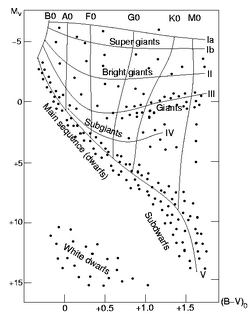
The main sequence of the Hertzsprung-Russell diagram is the curve along which the majority of stars are located. Stars on this band are known as main-sequence stars or dwarf stars.
This line is so pronounced because both the spectral type and the luminosity depend only on a star's mass (to zeroth order) as long as it is fusing hydrogen—and that is what almost all stars spend most of their "active" life doing.
At closer inspection, one notices that the main sequence is not exactly a line but instead somewhat fuzzy. There are many reasons for this fuzziness, the most important one still being observational uncertainties which mainly affect the distance of the star in question but range all the way to unresolved binary stars.
But even perfect observations would lead to a fuzzy main sequence, because mass is not a star's only parameter. Chemical composition and—related—its evolutionary status also move a star slightly on the main sequence, as do close companions, rotation, or magnetic fields, to name just a few. Actually, there are very metal-poor stars (subdwarfs) that lie just below the main sequence although they are fusing hydrogen, thus marking the lower edge of the main sequence's fuzziness due to chemical composition.
Astronomers will sometimes refer to the "zero age main sequence", or ZAMS. This is a line calculated by computer models of where a star will be when it begins hydrogen fusion; its brightness and surface temperature typically increase from this point with age. Stars usually enter and leave the main sequence from about when they are born or when they are starting to die, respectively.
Our Sun is a main-sequence star—it has been one for about 4.5 billion years and will continue to be one for another 4.5 billion years. It has the spectral classification of G2 V. After the hydrogen supply in the core is exhausted, it will expand to become a red giant.
Main sequence data
The table below shows typical values for stars along the main sequence. The values of luminosity (L), radius (R), and mass (M) are relative to the Sun. The actual values for a star may vary by as much as 20-30%. The coloration of the stellar class column gives an approximate representation of the star's photographic color. (Note: the following data are not in accord with the external link, and the luminosity per unit surface does not follow the law of being proportional to T4.)
Stellar
ClassRadius Mass Luminosity Temperature R/R☉ M/M☉ L/L☉ K O2 16 158 2,000,000 54,000 O5 14 58 800,000 46,000 B0 5.7 16 16,000 29,000 B5 3.7 5.4 750 15,200 A0 2.3 2.6 63 9,600 A5 1.8 1.9 24 8,700 F0 1.5 1.6 9.0 7,200 F5 1.2 1.35 4.0 6,400 G0 1.05 1.08 1.45 6,000 G2 1.0 1.0 1.0 5,900 G5 0.98 0.95 0.70 5,500 K0 0.89 0.83 0.36 5,150 K5 0.75 0.62 0.18 4,450 M0 0.64 0.47 0.075 3,850 M5 0.36 0.25 0.013 3,200 M8 0.15 0.10 0.0008 2,500 M9.5 0.10 0.08 0.0001 1,900
Reference
- Massey, Philip and Michael R. Meyer. "Stellar Masses." The Encyclopedia of Astronomy and Astrophysics. Ed. Paul Murdin. London: Institute of Physics Publishing Ltd and Nature Publishing Group, 2001. 3103-09. ISBN 1561592684